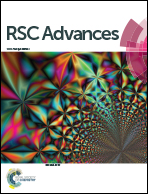Fabrication of a cubic zirconia nanocoating on a titanium dental implant with excellent adhesion, hardness and biocompatibility†
Abstract
A crystalline cubic zirconia (ZrO2) nanocoating was fabricated in situ on commercially pure titanium metal (cpTi) as a superior dental implant with enhanced biocompatibility. The crystallinity of the nanocoating was achieved at a moderately lower annealing temperature (350 °C) in air using a simple sol–gel method applying a successive layer-by-layer dip-coating technique. Such a procedure facilitates the growth of cubic phase zirconia without noticeable deterioration of the metallic Ti. The bioactivity and biocompatibility of this ZrO2 coated cpTi (Z-cpTi) were assessed in terms of apatite precipitation through immersion in simulated body fluid, and cell proliferation, respectively for several periods of time. The newly designed Z-cpTi showed unique apatite forming ability, better biocompatibility and tissue attachment properties, and is expected to reduce inflammatory response compared to the bare Ti implants. Moreover, the chemical inertness, corrosion and wear resistant properties, high strength, and appearance of this ZrO2 nanocoating suggest the probable expediency of Z-cpTi as an advanced oral implant for long-standing performance.


 Please wait while we load your content...
Please wait while we load your content...